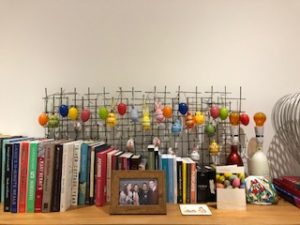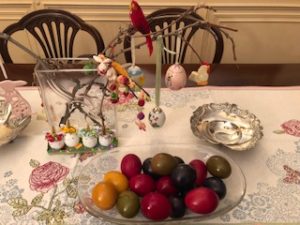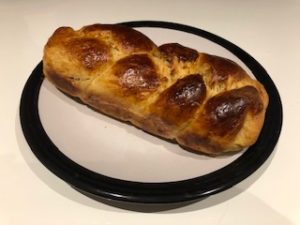The best recipe for tsoureki (Greek sweet bread)
This year, Greek Orthodox Easter (Pascha in Greek) is celebrated tomorrow, a month later than Easter observances in the Western Church. Although I am not religious, Easter is one of my favourite holidays, a time of the year that’s all about customs, rituals and traditions (some of which are personal that I religiously follow nonetheless). Sadly, once again they have been disrupted by the COVID-19 pandemic. To find some solace, I am baking a tsoureki, a sweet bread made by Greeks during Easter (as well as all year round).
But before I share the best recipe for tsoureki I’ve come across (in fact, the best tsoureki I’ve ever tasted), I’d like to reflect on all these Easter customs and traditions I’ve missed this (and last) year.
My favourite Greek Easter customs and traditions
When I lived in Greece, the Easter holidays would always begin with Lazarus Saturday, a week before Easter Sunday. As a child, and later as a University student, I would have a 2-week holiday starting on that day, the first holiday after the (also 2-week) Christmas break. This is when I would put the Easter decorations up: pastel-coloured eggs, bunnies and chicks hanging from a branch, a tradition that I have continued since moving to England. Not as extravagant as the Christmas decks, but enough to add some colour during the Holy Week.

Good Thursday
Then, on Good Thursday, there would be another splash of colour. This is when most people dye eggs red, to represent the blood of Jesus Christ. In my family, it was always my grandmother who did that, whereas my mother and I would dye eggs blue, green and yellow instead. I would then start drawing and painting on some of these dyed eggs, adding a bit more colour to them.

Good Friday
Although Good Friday is a day of mourning, a day that commemorates the Crucifixion of Jesus Christ, it is nonetheless my favourite day of the Holy Week. The highlight of the day is the Epitaph procession that takes place in the evening: symbolic coffins are carried through the streets of the Greek cities, with hundreds or thousands of people following each procession. Every year, I would personally follow at least two processions.
Good Saturday
The highlight of the Holy Week, however, is on Good Saturday, when thousands of people go to the church for the Resurrection Mass. Around midnight, the priest exits the altar holding candles lit by the Holy Light. This has been brought to Greece from Jerusalem, on an Aegean Airlines flight (that’s a fact), and has then been further distributed all over the country faster than the speed of light (thanks to some divine intervention that defies the laws of nature, unless you want to believe -God forbid- that the priest used a lighter). The Holy Light is then further distributed to everyone inside and outside the church. Once the priest exits the church and announces the Resurrection of Jesus Christ, most people walk back home, carefully holding their candles.

The Easter feast
The Resurrection of Jesus Christ marks the end of Lent and the 40-day fasting (as well as the beginning of my temporary vegetarianism). Although some people have been fasting for the 40 days leading up to Easter, many have only been fasting for the last week, whereas a few others (myself included) start fasting afterwards.
In the early hours of Easter Sunday, once people are back from the church, everyone sits around the table for a meal that I’d rather describe than eat.
But first, every person would choose one of the dyed eggs (preferably the red ones) and try to crack the others’ eggs, a tradition that reminds me of the Christmas crackers pulls. Unfortunately, the eggs are not the kind that contains useless plastic gifts. Because of this and since the egg that does not crack is expected to bring good luck to its owner, I always used a wooden egg (as a child). Well, I still do!
Eggs devoured (by everyone else apart from myself), it is time to eat magiritsa, a soup made from lamb offal and -thank God- consumed only on Easter. To avoid starvation, I personally eat a vegetarian version with mushrooms instead of offal.
The feast continues the next day (technically the same day), but hopefully after a good night’s sleep. In the morning, fires are lit to spit-roast the Easter lamb. In the afternoon, once it is ready, everyone sits once again around the table to crack more eggs and enjoy the roasted lamb and kokoretsi, a dish consisting of lamb or goat intestines wrapped around the offal. At this point, I have already excused myself and made my way towards the Easter tsoureki – thank God for that!

The Easter tsoureki
Tsoureki is a sweet bread made with flour, milk, butter and sugar and commonly seasoned with orange zest, mastic and mahlab. Although it is consumed all year long, it has a strong association with Easter (quite like the hot cross buns). The main difference between the normal tsoureki and the Easter variation is that the latter comes with an egg dyed red. It can be round or rectangular (as in my case below), and is usually consumed at room temperature, together with coffee, rather than as a dessert (or instead of a meal, as in my case).
I recently came across a recipe by Argiro Barbarigou that uses honey instead of sugar. Since I tend to substitute sugar with honey when I bake, I thought I’d give it a go. It was not only the best tsoureki I’ve ever baked, but also the best I’ve ever eaten (please note the past tense). For this reason, I decided not to tweak it all, not even halve the quantity, only translate it to English and share it.

Ingredients:
1 whole egg
1 egg yolk
125 grams butter
200 grams honey
200 grams milk
550 grams strong bread flour
2 sachets dry yeast
1 teaspoon mastic
1 teaspoon mahlab
Zest from 1 orange
1 egg (for brushing)
2 dyed red eggs (optional, for decoration)
Makes 2 loaves
Method:
In a bowl, whisk the whole egg and the egg yolk together.
In a pan, melt the butter and the honey over low heat (do not let the mixture come to a boil). Once melted, remove the mixture from the heat, and add the whisked eggs and the milk.
In a second bowl, mix the dry ingredients (the flour, the yeast, the zest, the mastic and the mahlab) together. Make a well in the middle, add the wet ingredients, and gradually incorporate the dry ingredients, kneading to a soft dough.
Cover the dough and let it rise for 2 hours. Then, put the dough in the fridge and let it rest for at least 6 hours.
Take the dough out of the fridge, and knead it a bit more. Cover the dough and let it rise for 30 min to an hour.
Divide the dough in half, and each half in thirds (so you get six roughly equal pieces in total).
Roll each piece into a long strip. Lay three strips next to each other and pinch the edges (on one side) to seal. Then, braid (plait) them, by folding one strip over the other, to form a rectangular tsoureki.
If you’re using a dyed red egg, you can place it on the tsoureki at this stage.
Place the tsoureki in a baking tray or a rectangular baking tin. Brush with an egg.
Repeat the process for the remaining pieces to form a second tsoureki.
Preheat the oven at 170 Celsius fan. Bake for 30 minutes.
Allow to cool.
Once the tsoureki has cooled down, you can wrap it in cling paper to keep it soft until ready to serve. You can also freeze it for future consumption.
Further reading
If you’ve enjoyed this post, check out my recipe for Samali: a traditional Greek mastic-flavoured cake.
Happy Easter!
Alex
(the hopefully-soon-to-be-Traveling-again Psychiatrist)